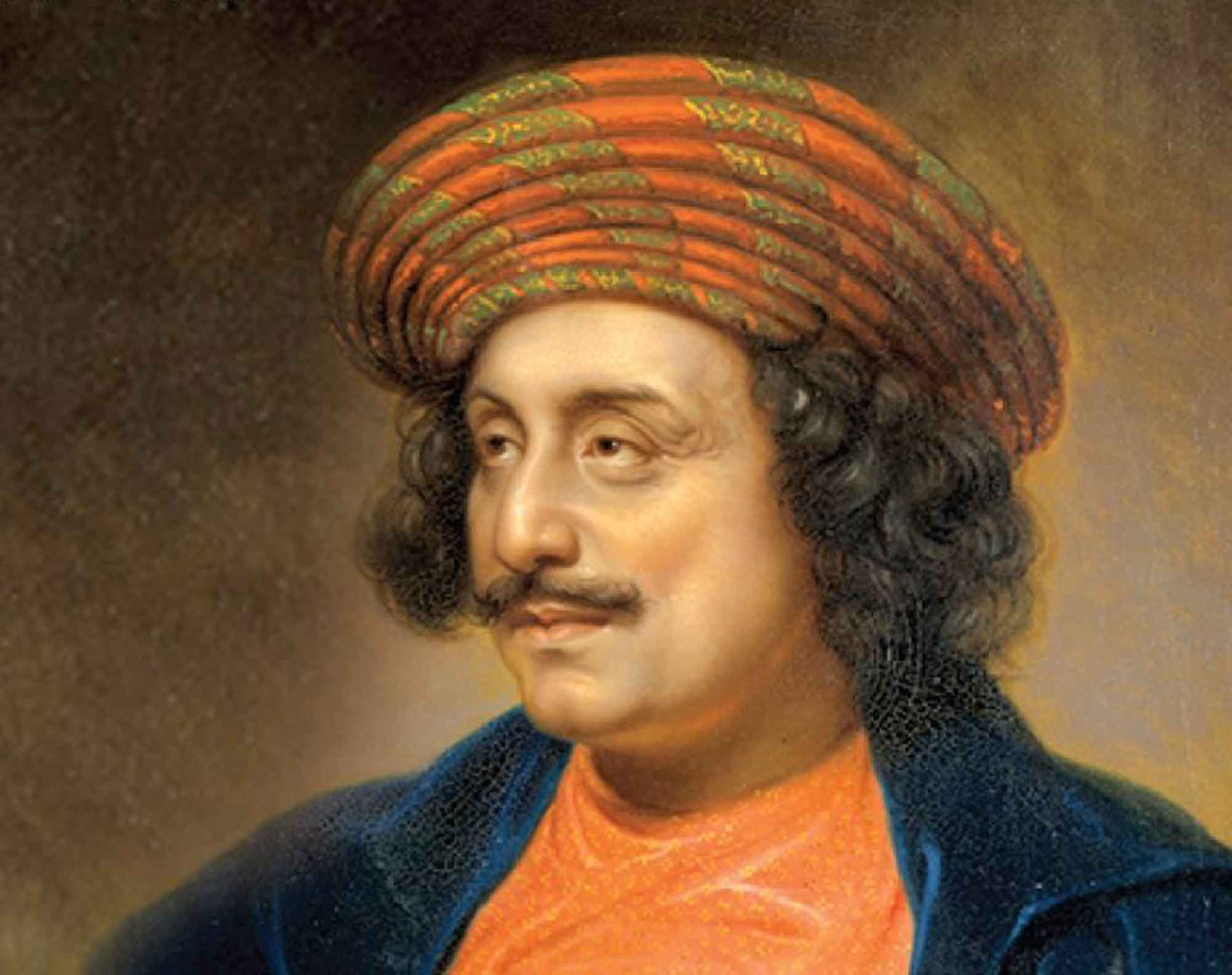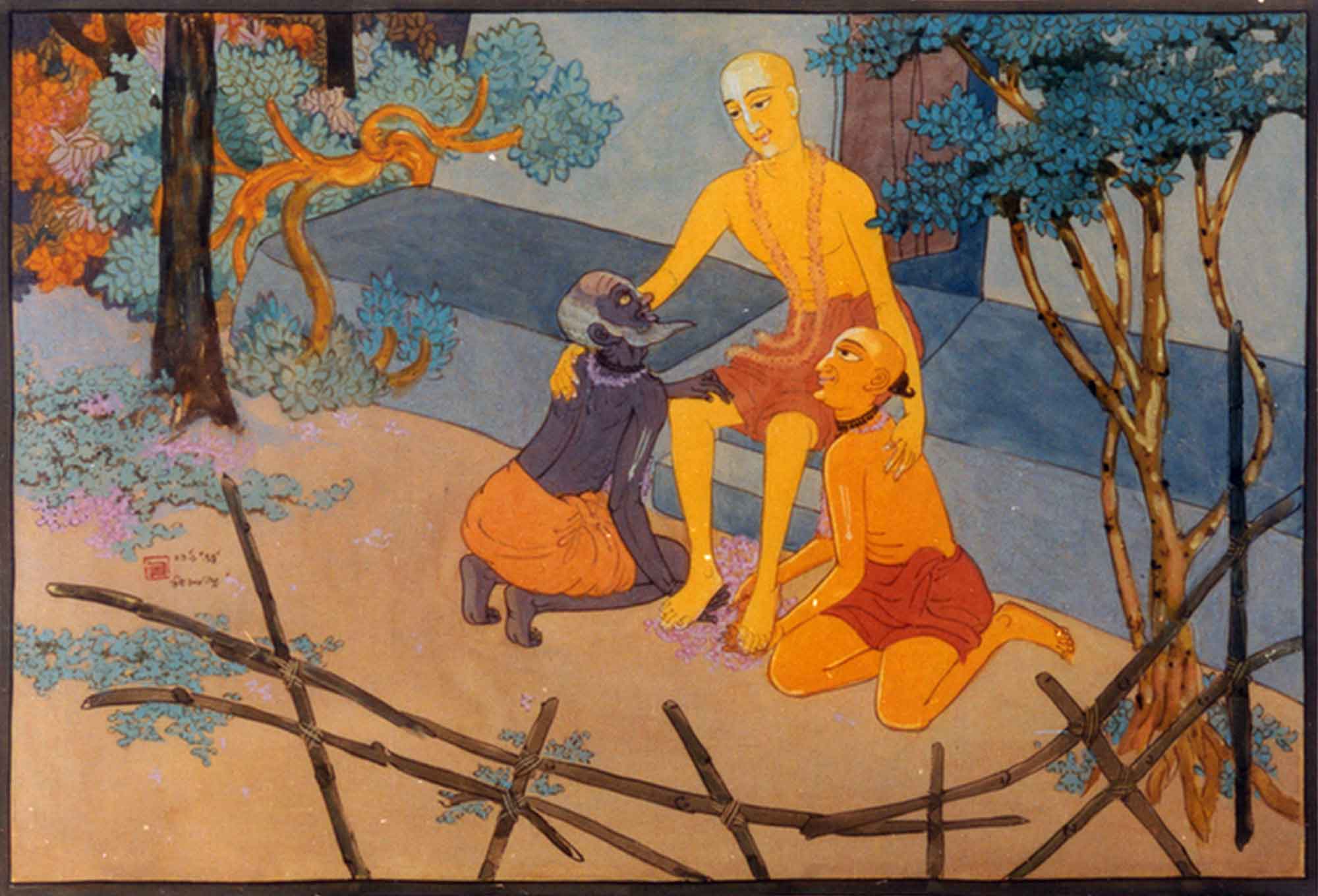Overview
The preface to Śrī Kṛṣṇa Karṇāmṛta was first published in Sajjana Toṣaṇī Vol.10. issue 1 in 1898. In this preface, Bhaktivinoda Ṭhākura explains the importance of Kṛṣṇa Karṇāmṛta to Śrī Caitanya, and how Śrī Bilvamangala Ṭhākura’s life reflects the lives of the jīvas in this world.
(translated by Swami B.V. Giri)
Bilvamaṅgala Gosvāmī is the author of this book. Śrī Caitanya Dāsa Gosvāmī, the brother of Śrīmat Kavi Karṇapūra Gosvāmī is its ancient commentator. Following this commentary, Kavirāja Gosvāmī has written his own commentary, Sāraṅga Raṅgdā. Śrī Caitanya Dāsa Gosvāmī is counted amongst the associates of Śrī Mahāprabhu. Thus, in the Tenth Chapter of the Caritāmṛta, Ādi-līlā we find:
caitanya-dāsa rāma-dāsa āra karṇapūra
tina putra śivānandera prabhura bhakta-śūra
(“Caitanya Dāsa, Rāma Dāsa and Karṇapūra – these were the three sons of Śivānanda and the Lord’s heroic devotees.” – Caitanya-caritāmṛta, Ādi-līlā 10.62)
The commentary by Caitanya Dāsa Gosvāmī is short, very beautiful and full of rasa. It is not good for such commentaries to become obsolete. There are many descriptions of the glories of Kṛṣna Karnāmṛta. Such things are written in the chapters of Caritāmṛta’s Madhya-līlā:
kṛṣṇa-karṇāmṛta śuni prabhura ānanda haila
āgraha kariyā puṅthi lekhāñā laila
karṇāmṛta-sama vastu nāhi tribhuvane
yāhā haite haya kṛṣṇe śuddha-prema-jñāne
saundarya-mādhurya-kṛṣṇa-līlāra avadhi
sei jāne ye karṇāmṛta paḍe niravadhi
(“Hearing Kṛṣṇa Karnāmṛta, the Lord became blissful, and with eagerness, He had the manuscript copied. There is nothing equal to the Karnāmṛta in the three worlds, for within it there is knowledge concerning pure prema for Kṛṣṇa. One who continuously reads the Karnāmṛta knows the beauty and sweetness of Kṛṣṇa’s līlā.”– Caitanya-caritāmṛta, Madhya-līlā 9.306-308)
Now just see how the teachings of Śrī Mahāprabhu are clearly written in two texts. Teachings on tattva are in Śrī Brahma-Saṁhitā, and teachings on bhajana are in Śrī Kṛṣṇa Karnāmṛta. Therefore, one who is a follower of Śrī Caitanya’s teachings should recite Kṛṣṇa Karnāmṛta with special care every day. We will describe something in regards to this book’s bhajana-praṇālī (method of bhajana) towards the end of our translation.
Śrīyuta Kavirāja Gosvāmī has written based on the tradition that Bilvamaṅgala Gosvāmī was a brāhmaṇa-paṇḍita living on the banks of the Kṛṣṇavenā River. First he was a materialist, then a brahma-jñānī, and finally he became a devotee of Kṛṣṇa. If we deliberate on this story, we can understand that this is the course of the jīvas in this world. The jīvas of this world are under three categories – prākṛta (materialistic), adhyātmika (seeking impersonal liberation) or aprākṛta (seeking transcendence) according to their qualification. People say that there are six darśanas (philosophies); however, we divide all those darśanas into three types, namely, prākṛta-darśana, adhyātmika-darśana, and aprākṛta-darśana. Nyāya, Vaiśeṣika and Pūrva-Mīmāṁsā are prākrta-darśanas. Sāṅkhyā, Pātañjala and the māyāvāda commentaries on Vedānta are the three adhyātmika-darśanas. Vedānta itself is aprākṛta-darśana. This is how we may describe all the activities found within these threefold darśanas.
Firstly, prākṛta-darśana –
(1) The concept of ‘I’ is caused by ignorance, and the concept of ‘mine’ is due to connection with all things acquired by the body. From ‘I’ and ‘Mine’ come the six changes of the physical body such as birth, growth, old age, dwindling, death etc., as well as mental perceptions, memory, acceptance and rejection, determination, the duality of hot, cold etc. and the appearance of lust, anger etc.
(2) From that ‘I’ and ‘Mine’ comes the sambandha-jñāna of the jīva related to his material designation, knowledge of enjoyment of the external world, karma, activities according to one’s position, varṇāśrama, attaining mundane objectives by worshiping the Devas who can give those particular results, the first seven limbs of Aṣṭāṅga Yoga, rules, regulations to attain puṇya, prohibition of pāpa, victory, fame, science and architecture.
(3) Puṇya created by mundane superficial knowledge, gives rise to temporary worldly happiness, various kinds of mental pleasures, and celestial delights.
(4) Quarrels, war, tension, pain, fear and lamentation arise from sinful propensities due to enviousness, and fall under the purview of materialistic superficial jñāna. They comprise of the miseries of this world and the miseries of the afterlife in the form of hell.
(5) The jīvas of the material world who are obsessed with prākṛta-darśana attain an inauspicious future destination, in other words, bondage. There are two types of bondage – the golden shackles of puṇya, and the iron shackles of pāpa. All this is the result of following prākṛta-darśana. As long as a man is materialistic, he is obsessed with this kind of philosophy.
Secondly, there is adhyātmika-darśana –
(1) One consciously renounces prākṛta-darśana.
(2) The opposite nature therefore is that of indistinct existence.
(3) That indistinct existence leads to the dry knowledge that everything is one.
(4) One becomes attracted to nirviśeṣa-jñāna (knowledge pertaining to impersonal non-differentiation).
(5) One thinks that the way to become free from material bondage is to desire sāyujya-nirvāṇa (merging into the impersonal Absolute).
These five make up adhyātmika-darśana. Even though there may be meagre knowledge of material sense objects, as long as there is no attention placed upon aprākṛta-darśana, then one remains mired in this philosophy.
Thirdly, there is aprākṛta-darśana –
(1) It is knowledge or pure knowledge. It is special and variegated knowledge that transcends material nature. Material nature is the shadow or perverted reflection of this variegated knowledge.
(2) Pure Vedāntika knowledge disregards that which is merely mundane science, as well as prākṛta-darśana and adhyātmika-darśana.
(3) Endeavours in bhakti concerning knowledge of the relationship between śakti and śaktimata (the energy and the energetic) produces pure knowledge.
(4) There is a yearning for the association of pure devotees.
(5) One perceives prema as aprākṛta-ānanda-cinmaya-rasa (that rasa which is transcendentally blissful with no tinge of matter.)
This knowledge, namely aprākṛta-darśana, is the attainment of pure kṛṣṇa-bhakti. This is the glory of the jīva.
Initially, Bilvamaṅgala Gosvāmī followed prākṛta–darśana. Taking refuge in pāpa, he was extremely attached to the prostitute, Cintāmaṇi. Once, he crossed the Kṛṣnavenā off-season, and with great difficulty and went to see Cintāmaṇi. Observing Cintāmaṇi’s renunciation and hearing advice from her, his initial interest in adhyātmika–darśana was born. He has expressed his two conditions in the śloka, advaita-vīthī-pathikair upāsyāḥ (‘I was worshiped by those on the path of non-dualism’). Eventually, by the association and teachings of the Vaiṣṇavas, he became a devotee, and his attraction for aprākṛta–darśana was born. When that attachment became mature, kṛṣṇa–rasa manifested within him.
Aprākṛta–darśana has three stages – sādhakāvasthā (the stage of sādhana), bhāvāvasthā (the stage of bhāva) and premāvasthā (the stage of prema). In sādhakāvasthā, one simply engages in sādhana of the nine limbs of bhakti such as śravaṇa, kīrtana etc. There is a difference between vaidha and rāgānuga in sādhakāvasthā. By gradually following this, greed was aroused within Bilvamaṅgala Mahāśaya for rāgānuga-bhakti. In no other text has he described his sādhana. This book describes premāvasthā. The internal and external stages are indicated in all the ślokas.













